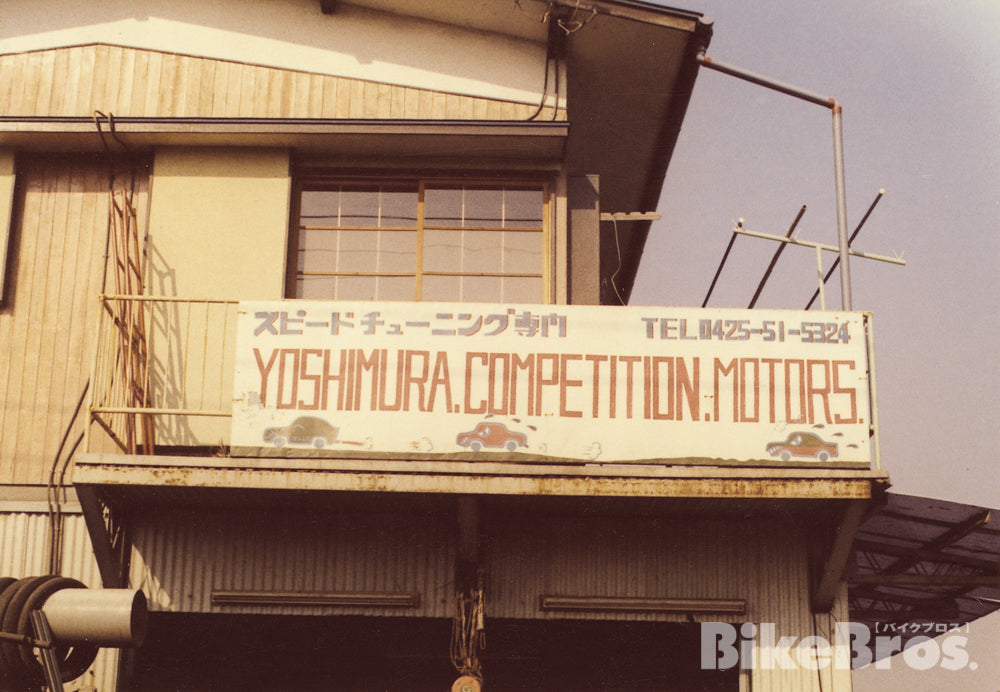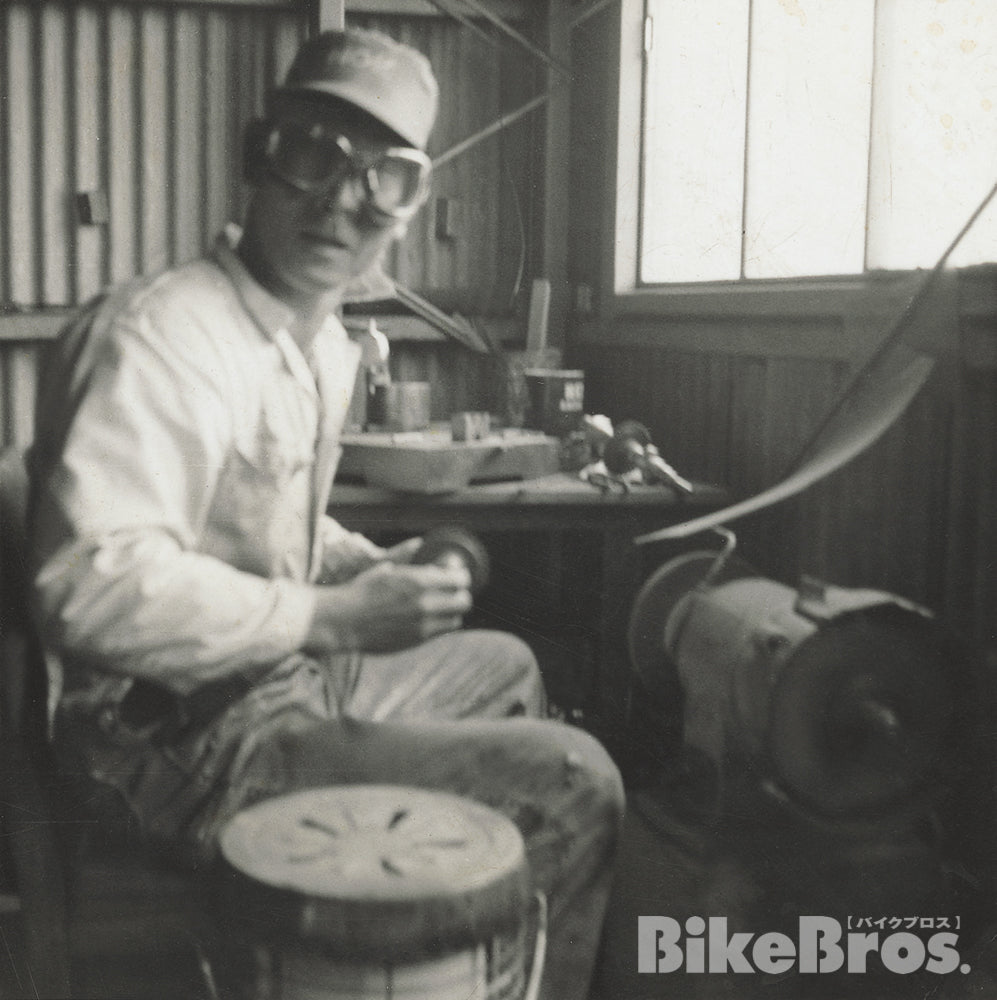Pop goes to the capital where competition gets tougher at every corner.
1965-1966: Starting Up Yoshimura Competition Motors
After several years of consideration, in 1965, Pop made a significant decision in his career –––– leave Kyushu and go to Tokyo. The focus of his profession had shifted dramatically from the time when he opened the little repair shop “Yoshimura Motors” in 1954. Pop had already become a notable engine tuner through road racing at Gannosu, and he knew it was time for him to leave.
In April, the Yoshimura’s (excluding Fujio who was preparing for his high school entrance exams) moved to Fussa, a suburb of Tokyo, right next to the U.S. Yokota Air Base. Although Fussa belonged to the greater Tokyo area, it was at that time a smaller town than Zasshonokuma. The new shop Pop opened in Fussa bore the English inscription “YOSHIMURA COMPETITION MOTORS.” The now world-famous “ヨシムラ” logo (Yoshimura spelled in Katakana which to American eyes looked like “three equal forty seven”!) was also introduced around this time.

The signboard of the Akigawa factory reads: Speed Tuning Specialist, Yoshimura Competition Motors. Numerous U.S. military facilities, including Yokota, Johnson and Tachikawa, were in the vicinity in 1965.
The mid 60’s were a turning point not just for Yoshimura and its field of activity, but for the whole Japanese motorsport scene as well. New paved race tracks were built one after another: Suzuka Circuit (6 km long) in 1962, Funabashi Circuit (3.1 km) in 1965 and Fuji Speedway (6 km) in 1966. The races that were staged on makeshift tracks at Asama, Gannosu and other U.S. military bases throughout Japan gradually faded away as these new paved race tracks were built.

On any Sunday, wherever you are! Back then in Tokyo, two nearby U.S. military facilities, the Yokota Air Base in Fussa and the Johnson Air Base in Iruma, held racing events on Sundays, and among them the easiest to participate in were drag races. The rules were simple, and many Yoshimura-tuned CB72/77s have made their debut on the airstrips.

The Fuji Speedway opened in 1966 as an international-standard race track. In the beginning it was a 6 km course with a 1.7 km long main straight and a 30° bank. All of these features made it advantageous to the powerful machines and courageous riders such as Yoshimura’s. This photo depicts a view from Fuji’s grandstand. It faces both the main straight and the hairpin turn.
Looking back on 1962, Pop succeeded in bringing the 5th All-Japan Motorcycle Clubman Race to the Gannosu Air Station (the race was co-organized by Motorcycle Club Federation of All-Japan and Kyushu Timing Association). In 1963, the first Japanese Motorcycle Grand Prix took place at the newly opened Suzuka Circuit. The year 1964 brought the Suzuka 18 Hour, the first official motorcycle endurance race in Japan, in which Pop and his Kyushu team (with Yoshimura-tuned Honda CB’s) defeated the Honda R&D team.
Then in 1965, the astonishing speed of the Yoshimura-tuned CB72’s in the Japanese Grand Prix Junior Class, ridden by Fukumi Kotake (who learned to race from Pop in Gannosu and then from Kenjiro Tanaka at the Honda-sponsored racing school) and Masahiro Wada (later became a Kawasaki factory rider), had caught the eye of Soichiro Honda. In shock, Mr. Honda himself ordered his engineers to test the Yoshimura CB. Considering it as an honor and an opportunity to contribute to technological development, Pop let his bike undergo series of tests at Honda’s Motorcycle R&D department in Wako.
Honda engineers were stunned by the amount of power it was producing. While the stock CB72 engine made 24 hp and the Honda R&D version made a little over 27 hp, the Yoshimura-tuned unit made more than 32 hp. Not everyone of the Honda engineers was comfortable with the achievement “some local bike shop” had obtained.
By the time of the Suzuka 18 Hour in 1964, the Yoshimura CB72 (SOHC) was already delivering as much power as the Honda CR72 production racer (DOHC) and Yamaha YDS (2-stroke), even though it was detuned for the endurance race. After the evaluation, Soichiro Honda told his engineers to beat Yoshimura in 2 weeks.
As a competitive and passionate leader, Soichiro just wanted to inspire his employees to do their best. He had no intention to start a feud but this incident had definitely hindered the relationship between the two companies in the upcoming years. Although Honda R&D later succeeded in extracting more power from their CB72 racing engines, it must have been embarrassing for some to be compared to Yoshimura.
In the 60’s most motorcycle manufacturers were focused on designing and producing their products and performance tuning was not their specialty. Something similar had happened in the 1982 AMA Superbike when the CB750F American Honda tuned for Freddie Spencer made an incredible 150 hp.
In 1965, Pop was asked by Fumito Sakai (MCFAJ Vice-Chair and Yaesu Publishing president) to contribute to his Motorcyclist magazine. Pop’s monthly articles ran from February to April 1965 (on motorcycle tuning), and then from April to August 1967 (on 4-stroke engine tuning).
Pop’s track-proven, detailed 4-stroke engine tuning tips ranged from carburetor selection to cylinder head modification, which involved valve timing adjustments and high-lift camshaft fabrication. All of this helped make Yoshimura a national brand. The series of articles was the first of its kind in Japan, and was well received by many, including the Honda engineers who built the CB72/77. Even to this day it is regarded as a bible among enthusiasts.

Grinding and polishing engine parts to a mirror finish is now known to cause friction increase, but back then it was considered as the best option to squeeze more power out of an engine. Although covered with white dust from buffing, the ex-aviator looks great with goggles on!
The magazine articles brought more customers to the Yoshimura shop. Pop, his family and the employees all began their day at 7 a.m. and worked until midnight. Pop worked on all the camshafts with his own hands. He reshaped them using a bench grinder and oil stones, checked them with a dial gauge and a 360 degree protractor, and then repeated the process over and over until it was perfect by applying his intuition, experience and his own theories.
Ports, valves and crankshafts were mirror-finished to improve the volumetric efficiency and to reduce the friction. Transmission gears were also polished. Swingarm reinforcements and fork braces were added to improve the chassis rigidity. The tuning was not limited to the engine.
Yoshimura has been tuning motorcycle chassis since when they were racing at Gannosu. The nonstructural components on their bikes were already filled with lightening holes (Yoshimura’s “drill holes” later became famous in the era of Kawasaki Z1 & Suzuki GS). Unlike most other tuners and parts manufacturers who are focused on a specific component (such as engine tuners and cam specialists) Yoshimura has always been, and continues to be, the one who can handle them all.

Pop never gave up tuning for more power and better drivability. In their last years, Yoshimura-tuned CB72’s were producing around 40 hp. This worsened the lack of stopping power, even with a 2-leading-shoe race brake. Note the hand-bent twin megaphones and the early Keihin CR's.
Pop’s methods had been proven on race tracks time-and-time again. Pursuing the next higher level of tuning however, required more effort and time, and yet he still handled every request with the utmost professionalism and courtesy. Concurrently, Kotake won the All-Japan Junior Champion title in 1965, and Wada was attracting increasing attention for chasing 2-strokers real hard.
While Yoshimura was earning a reputation and gaining national recognition, a serious problem was developing. Honda began to restrict their Genuine Race Kit parts (base parts) supply to Yoshimura. Supposedly, someone was envious of Yoshimura's success. To try and resolve the supply problem, Pop finally contacted Soichiro to ask about it, but it just made the situation worse. It is said that Soichiro furiously blamed the incident on his employees. By the end of 1965 the relationship with Honda ceased completely. Honda then established their Racing Service Center (the predecessor of Honda Racing Corporation) in order to develop and supply genuine racing parts.
During this time, two young fans of Pop’s entered the Yoshimura working scene: Ken Matsuura (who in 1966 drove all the way from Ehime on a Honda S600), and Mamoru Moriwaki (who in the same year rode all the way from Kobe on a Honda CB72). The two later respectively became globally-recognized as racing constructors / tuners.
In 1966, Yoshimura moved to Akigawa, few kilos away from Fussa. Pop had to borrow money to build the new factory but it was worth it. Since it was located in a rural area, there was no need to be concerned about making a lot of noise. From that moment on, Yoshimura began to tune more automobiles, and the name Yoshimura increasingly became even more important to the Japanese motorsport scene.

Mrs. Yoshimura, in between her two daughters Namiko and Yumiko, poses in front of a transporter truck supplied by a Nishitama Speed Club member. Fuji Speedway was about two hours away from Akigawa.


1 comment
Very instructive and entertaining to read this site. I knew Pop Yoshimura from my time racing and interpreting at Suzuka (1964). When I arrived in Japan for the 1966 Japan Grand Prix at FISCO, I brought along an Aermacchi 350 which I’d never ridden before. It blew up in practice, so I had no ride in the race. Pop very kindly invited me to ride one of his tuned-up CB-77s which had just finished a Junior race. I went out on the bike and proceeded to crash it in a high-speed left hander at about 170 km/h. No problem – we hammered it together and I rode in the race, finishing in 4th Place, for 3 World Championship points in 350cc. I am immensely grateful to Pop Yoshimura and also to Fujio-san,whom I hosted in California in 1968. They are fine examples of that “Kyushu danji”.